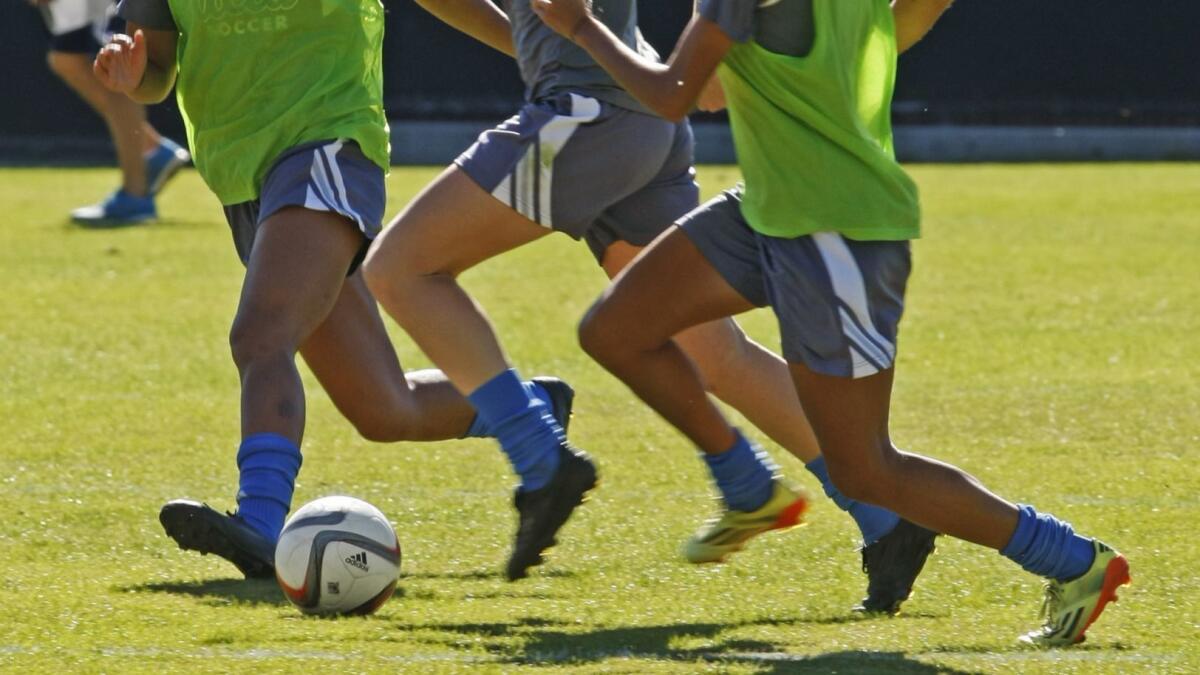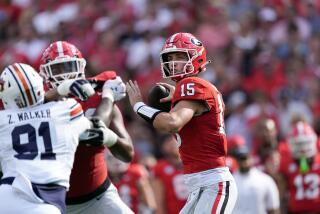Op-Ed: The NCAA deserves its greedy reputation. Expanding athletic scholarships could change that

- Share via
The NCAA and its member schools have long had an image problem. The public perceives them as greedy, more about the money than the players on the field or court.
It’s easy to see why. The NCAA now rakes in a billion dollars a year, but for players it may as well be the 1950s, when the governing body for college sports coined the term “student-athlete” in a bid to fight insurance claims.
By recently creating a group to study the issue of letting players profit from the use of their names and likenesses, the NCAA may be finally willing to address this historical income inequity while sticking to the amateur model — meaning the players wouldn’t receive salaries.
California is already moving ahead on this front with a “fair pay to play” bill that would prohibit the NCAA from banning a university from competition if its athletes were allowed to make money from their names and likenesses.
Yet any discussion of paying college players invariably leaves out a huge swath of athletes who compete at the highest level, Division I.
To truly make college sports fairer to the players, the NCAA needs to offer meaningful financial help to a more inclusive and much larger group of varsity athletes. That would take a couple of simple yet bold moves to bring the NCAA’s actions more in line with its mission to help student-athletes succeed. Any improved compensation should also have an educational component.
Casual fans often make the mistake of assuming that all college athletes get full scholarships at the big sports schools. Not true.
If the NCAA resolves to let players make some coin off their images being used in a video game or through a jersey being sold with their name on it, then it stands to reason that the players whose images are in demand, and who presumably will earn the most money, are stars of the most popular and most lucrative sports — football and men’s basketball.
When many fans and pundits talk about paying the college players, they often mean paying only star athletes in a few sports. They are immediately cutting out many other varsity athletes from the picture.
Big names like Kyler Murray, the Oklahoma quarterback picked No. 1 in the 2019 NFL draft or basketball power forward Zion Williamson of Duke University would be in demand. Many lesser names would not be.
What about the relatively anonymous second- and third-stringers who contributed by getting run over by Oklahoma’s starting linemen in practice?
Football and men’s basketball players account for only a fraction of the varsity athletes at the big Division I schools, which is what the NCAA group is studying.
For instance, at Penn State University, where I teach, there were about 820 athletes (not counting them twice if they played more than one sport) in the 2016-17 school year. Only about 130 athletes played either football or men’s basketball.
Casual fans often make the mistake of assuming that all college athletes get full scholarships at the big sports schools. Not true.
Under NCAA rules, a few men’s and women’s sports at Division I schools are designated as “head count” sports, which essentially means a full scholarship is awarded to most of those who play that sport. For example, each school can give 85 such scholarships for football.
However the vast majority of sports are not head-count sports but “equivalency sports” — those that don’t generate revenue. Equivalency sports typically have a set number of scholarships, which coaches can split up any way they like. But there is not enough funding to give every scholarship recipient a full ride, or sometimes any scholarship at all.
For example, women’s NCAA soccer had a whopping 333 teams in 2017-18, with each school averaging about 28 players. But each college’s scholarship limit was 14. Many of the 9,380 athletes who competed in women’s Division I soccer undoubtedly received only a partial scholarship, if anything.
Many athletes at major universities spend about 34 hours a week working on their sport, according to NCAA research. And its member schools get ever richer because of it.
The NCAA has the power to change this ridiculously lopsided financial equation.
It should start by requiring Division I schools to give much more generous scholarships to equivalency sports athletes. This move, while costly, would finally recognize the hard work of thousands of students representing hundreds of schools in a way that really matters.
Athletes also could be offered a deal that would allow them to extend their studies after their NCAA eligibility runs out, counteracting a well-documented effect of college sports called “clustering” that refers to moving athletes into less-demanding majors that free up time for them to train.
Enter the Fray: First takes on the news of the minute »
This could be accomplished by allowing athletes who meet service requirements at a university — such as earning a varsity letter or competing for three years — to complete a second bachelor’s degree or a master’s at reduced cost after their eligibility is exhausted.
The pushback to most any argument involving better compensation for athletes often goes like this: Colleges have leveraged all their money into constructing new stadiums and workout facilities, and they won’t be able to pay their coaches. But any monetary changes could be phased in.
Does NCAA President Mark Emmert need to make a $3.9 million salary? Do the top 25 highest-paid football coaches need contracts worth $4 million and up? Are the top 20 assistant coaches all worth more than $1 million apiece?
NCAA member schools created the market for high-priced coaches with huge staffs, and now they need to reshape it by changing NCAA rules.
The best way to help the most college athletes succeed is not so much about paying players as it is about paying for their educations — and helping them succeed on the playing field of life.
John Affleck is director of the John Curley Center for Sports Journalism at Penn State University.
More to Read
A cure for the common opinion
Get thought-provoking perspectives with our weekly newsletter.
You may occasionally receive promotional content from the Los Angeles Times.










